
This site runs ads and generates income from affiliate links. Read my disclosure policy.
Learn how to make perfect Spaghetti Alla Carbonara every time. This classic Italian recipe is s must-have for any pasta lover!
Serve with homemade garlic bread for an easy weeknight supper.

You may be surprised that Spaghetti Carbonara is the easiest pasta dish you’ll ever make! With just a handful of ingredients, you’ll have a creamy pasta dish loaded with Parmesan cheese and crisp pork that’s out of this world! Oh, and it’s ready in just 15 minutes! What more can you want?
Why This Recipe Works
- The extra egg yolks give the sauce an extra creaminess.
- The cured pork and a little garlic add an extra depth of flavor and crispy texture.
- Adding pasta water helps to make a silky sauce.
- Combining Pecorino Romano and Parmesan cheese gives creaminess with a little sharpness.
Are Eggs Raw In Carbonara?
The eggs are added to the hot pan off direct heat to avoid becoming scrambled eggs. The residual heat of the pan and the freshly cooked pasta is more than enough heat to cook the eggs, making them safe to eat. You know the eggs are cooked when they thicken with a glossy creaminess.
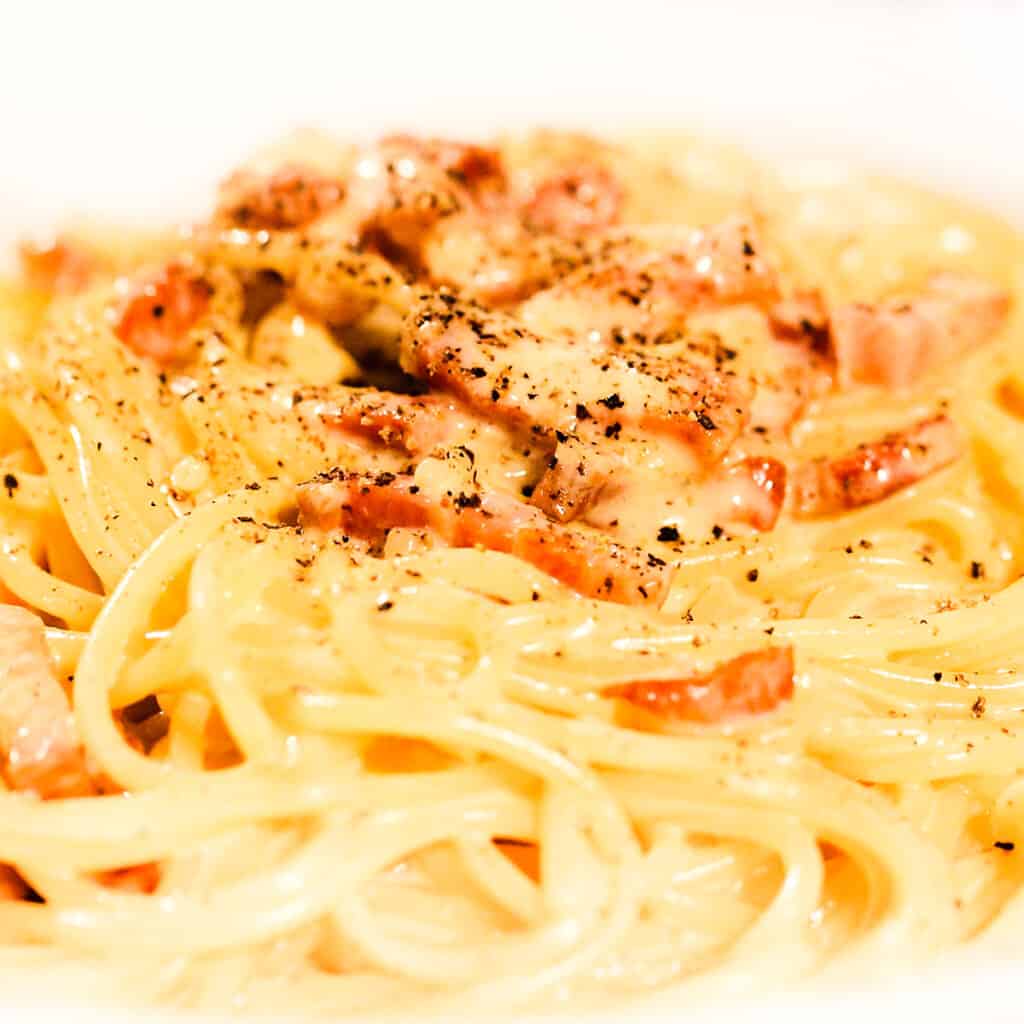
How to Stop the Eggs from Scrambling
It could seem daunting, but Spaghetti Carbonara is easier than you might think. The secret to achieving a silky sauce is timing. Before adding the spaghetti, take the pan off the heat for a couple of minutes. If your pan is hot, it will cook the eggs too quickly. Let the pasta cook the eggs – not the pan.
Add the egg mixture immediately after draining the pasta. You want the pasta to be hot, so the eggs cook and set the sauce. When you add the egg mixture to the spaghetti, keep it moving, adding reserved pasta water as needed until the sauce is the consistency you want. Serve immediately, and don’t attempt to return the pan to direct heat.
Ingredient Notes

Pork: Traditionally, Spaghetti Carbonara is made with guanciale, cured pork cheek, similar to pancetta. Guanciale is not as readily available and can be substituted with pancetta or bacon. Both options work just as well. If using guanciale, be sure to trim the skin before using it.
Pasta: Spaghetti is traditional, but you can use any pasta you like best such as fettuccini, linguini, bucatini, or rigatoni. Cook until al dente with a little bite. I recommend good quality dry pasta as it’s easier to cook al dente than fresh.
Eggs: Use room temperature large or jumbo eggs. Yellow eggs will give a more subtle yellow color, while brown eggs will produce a richer color.
Reserved Pasta Water: The hot, starchy pasta water is the secret to a luscious carbonara sauce. With just a small amount, your carbonara sauce becomes the creamy masterpiece it’s famous for.
Cheese: I use Pecorino Romano and a little Parmesan cheese. Authentic Spaghetti Alla Carbonara is made with only Pecorino Romano. Some Italians would be offended by the use of other cheeses, so if you want an authentic Carbonara, use only Pecorino Romano. Whatever you choose, be sure to use freshly grated cheese for the smoothest result.
Pepper: Black pepper is a key ingredient in Carbonara sauce. Freshly grated black pepper is best as its aroma and flavor dissipate quickly.
A Note on Garlic: I get a lot of comments regarding garlic. Many people feel it’s a necessary ingredient. It’s not a traditional ingredient, but if you want to add it, I recommend using crushed whole, peeled garlic cloves. Cook them with the pork to add flavor and remove it before adding the pasta.
Tips for Making Perfect Carbonara
- Use room-temperature eggs. Cold eggs may not cook to a food-safe temperature.
- Whisk the eggs well until the whites are completely incorporated into the yolks to avoid lumps.
- Salt the pasta water well. This is your chance to add flavor. The pasta will be bland if not salted enough.
- Reserve the pasta water – the starchy water adds flavor and silky texture to the sauce.
- Use freshly grated cheese as store-bought, pre-grated cheese doesn’t melt as well and could be grainy.
- Use a cold pan for crisp, cured pork because it allows the fat to melt out slowly and prevents the meat from seizing, which locks in the fat.
- Be sure to remove the pan from the heat before adding the eggs. Don’t just turn off the burner; move the pan off the burner completely.
- Once the pasta is drained, add the egg mixture immediately and keep the pot off the heat.
- Stir the pasta as you add the egg mixture to distribute the sauce evenly and coat the pasta well.
- A slight curdle is okay. When you add the eggs to the hot pasta, they may start to curdle (but they won’t scramble if the pan isn’t too hot) – This is just fine.
- The cured pork and cheese may be salty, so wait until the end and then taste before adding the salt.
- Serve immediately – Carbonara tends to dry out as it cools, so enjoy it while it’s still hot!
Step By Step Instructions
Add eggs, egg yolk, Parmesan cheese, and Romano cheese to a small bowl.

Whisk together until the whites and eggs are fully incorporated and set aside.
Heat a large pot of salted water over high heat, boil it, and start cooking the pasta.

While the pasta cooks, heat the oil in a large skillet over medium-high heat and cook guanciale, pancetta, or bacon until brown and crisp.
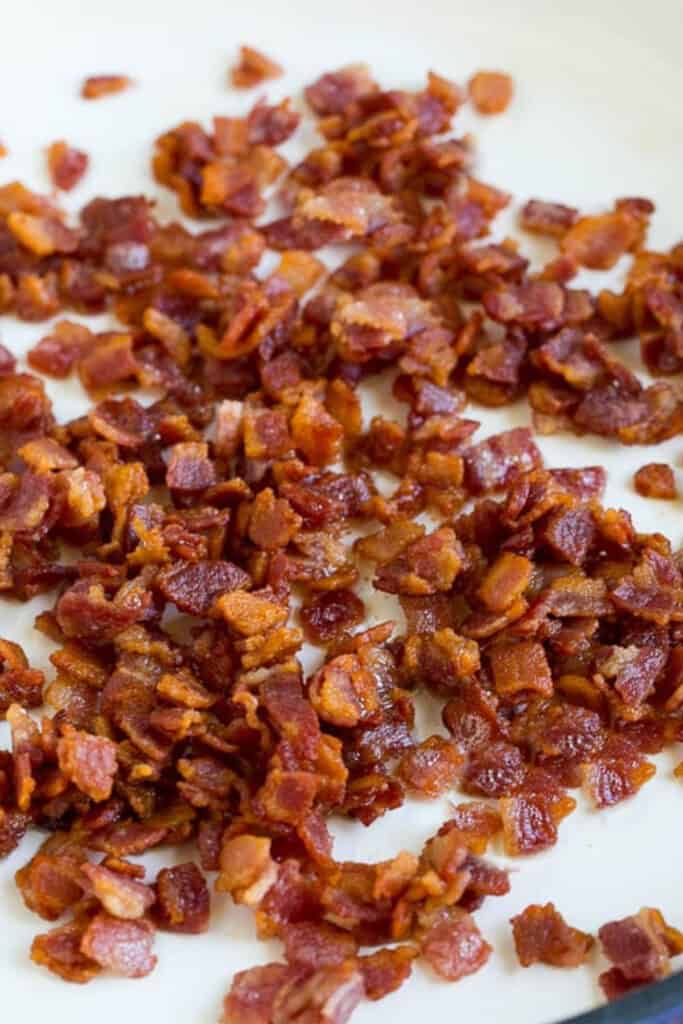
You want to keep the fat in the pan. It adds a lot of flavor. If there is an excess of fat in the pan, drain some, but lease about two tablespoons of the fat. Then remove the pan from the heat for one to two minutes before draining the pasta.
Reserve a half-cup of pasta cooking water before draining.
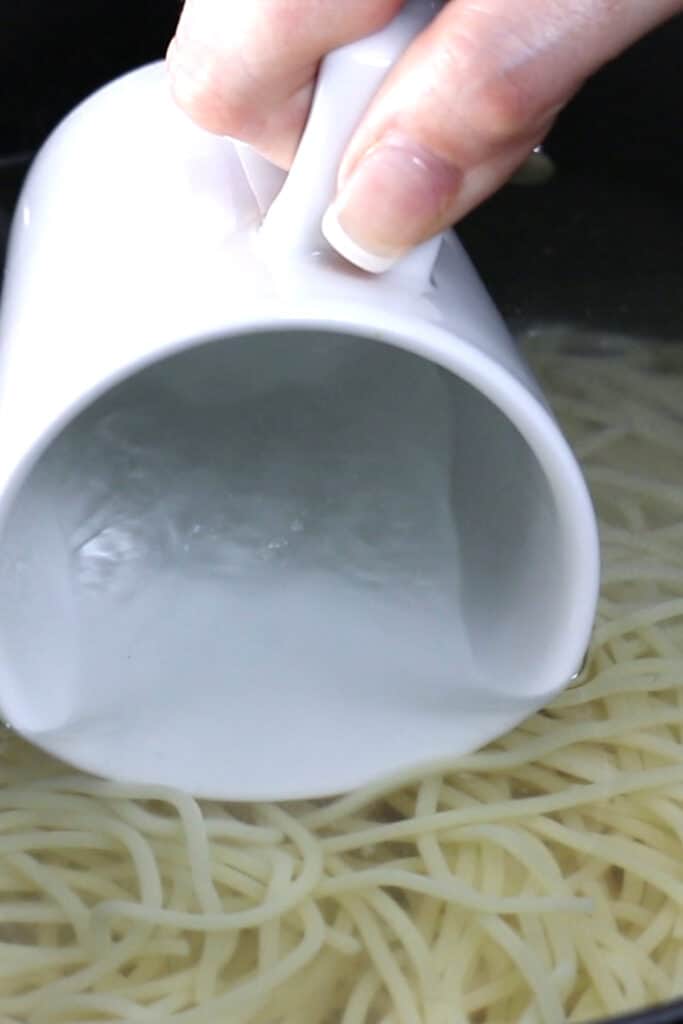
Drain the pasta briefly, leaving the pasta slightly wet. Gradually add the egg mixture and gently toss it together to cook the eggs with the hot pasta.

Add some reserved pasta water as needed for creaminess until the sauce is your preferred consistency.

Taste for seasoning and add more salt as needed. Spaghetti Alla Carbonara should be served immediately as it can dry out quickly out as it cools, so enjoy it while it’s still hot!

FAQs
Is Carbonara sauce meant to have cream?
Traditional Carbonara does not contain cream. Although the sauce is creamy, it’s made with eggs and cheese.
Is carbonara raw egg?
No, the residual heat of the pan and the freshly cooked pasta is more than enough heat to cook the eggs, making them safe to eat.
Can you reheat Spaghetti Carbonara?
Spaghetti Alla Carbonara is best served fresh, and reheating can cause the eggs to cook too much. If you must reheat, heat on the stove over low heat until warmed through. You can use a little water to loosen it as needed.

Recipe
Spaghetti Alla Carbonara
Ingredients
- 2 large eggs (room temperature)
- 2 large egg yolks (room temperature)
- ¾ cup Pecorino Romano cheese (freshly grated)
- ¼ cup Parmesan cheese (freshly grated)
- 1 lb spaghetti
- 2 tablespoons olive oil
- 6 oz guanciale ((pancetta or bacon) trimmed of skin and chopped)
- 1 cup pasta cooking water (reserved before draining)
- salt (to taste)
- freshly ground black pepper
Instructions
- Whisk the eggs, cheese, and pepper in a small bowl until well combined; set aside.
- Heat a large pot of well-salted water over high heat and bring it to a boil for the pasta.
- Starting with a large, cold pan, cook the guanciale (pancetta or bacon) in olive oil over medium-high heat until brown and crisp, about 6-8 minutes.
- While the pork cooks, add the pasta to the boiling water and stir to separate. Cook until just under al dente (7- to 8 minutes).
- If there is excess fat in the pan with the pork, drain all but 2 tablespoons from the pan. Remove the pan from the heat one to two minutes before the pasta is done cooking.
- When the pasta is ready, reserve a cup of cooking water before draining the pasta briefly, leaving the pasta slightly wet.
- Add the freshly drained pasta to the pan with the pork and gradually stir in the egg mixture. Add some reserved pasta water to loosen the sauce until it reaches your desired consistency (you may not use it all).
- Taste for seasoning and add more salt as needed. Serve immediately with additional grated cheese and pepper.
Tips
- Use room-temperature eggs. Cold eggs may not cook to a food-safe temperature.
- Whisk the eggs well until the whites are completely incorporated into the yolks to avoid lumps.
- Reserve the pasta water – the starchy water adds flavor and silky texture to the sauce.
- Use freshly grated cheese – You want it to melt into the sauce, and store-bought, pre-grated cheese doesn’t melt as well as freshly grated.
- Be sure to remove the pan from the heat – This is where carbonara can go terribly wrong. Don’t just turn off the burner; move the pan off the burner completely, or you’ll end up with scrambled eggs.
- Add the egg mixture immediately after draining the pasta, and keep the pot off of the heat. You want the pasta to be as hot as possible, so the eggs cook and set the sauce.
- A slight curdle is okay. When you add the eggs to the hot pasta, they may start to curdle (but they won’t scramble if the pan isn’t too hot). This is just fine and gives the Carbonara sauce its signature creaminess.
- The bacon and cheese can both be salty, so be sure to wait until the end and taste before adding salt.
- Serve immediately – Carbonara tends to dry out as it cools, so enjoy it while it’s still hot!
Update Notes: This recipe was originally posted in January 2021. It was republished with new photos, tips, and ingredient notes in 2022.






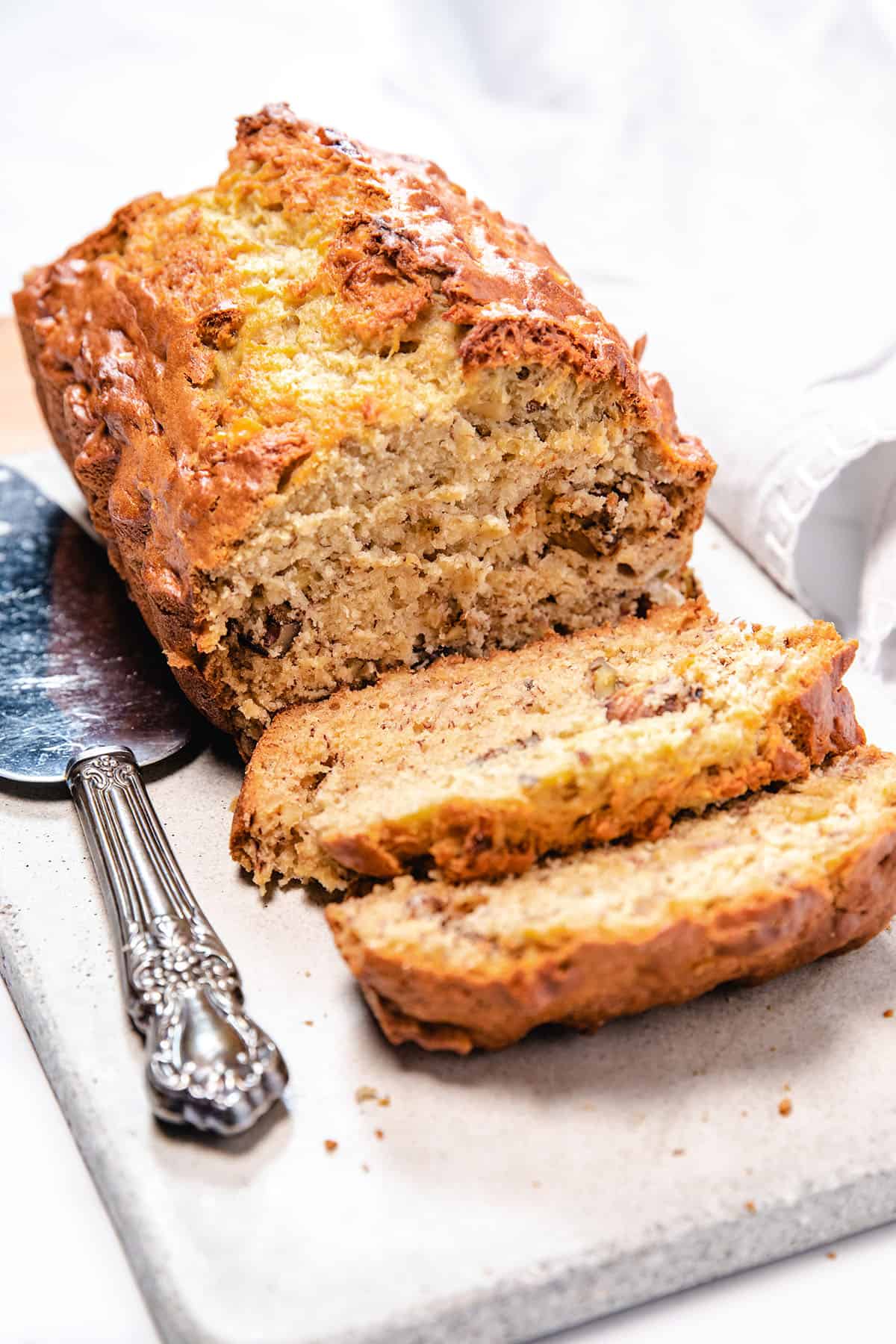




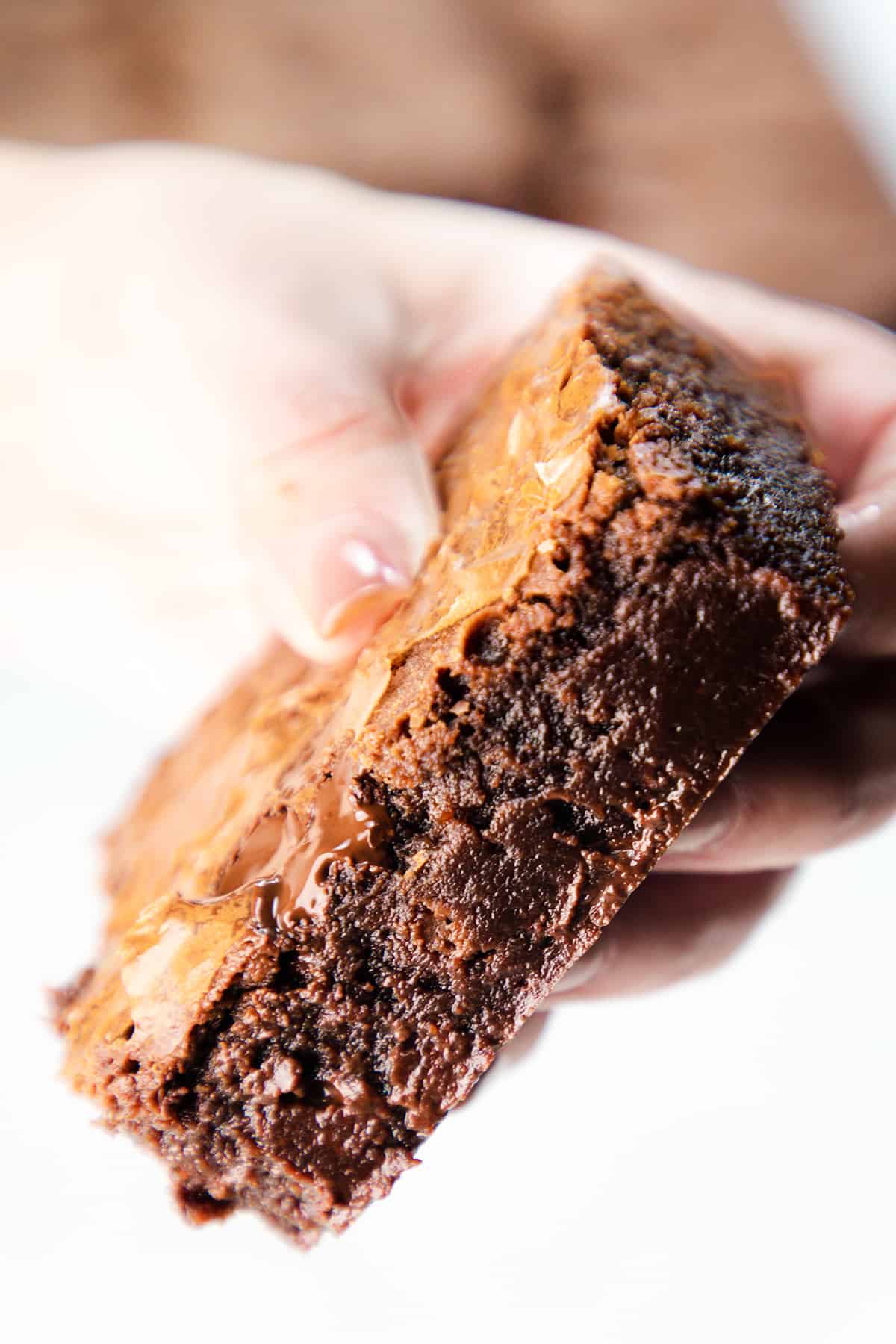




Leave a Reply